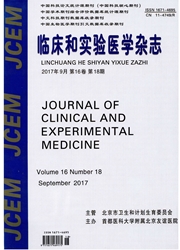

 中文摘要:
中文摘要:
目的探讨后循环缺血(PCI)与椎-基底动脉变异的相关性。方法采用病例对照研究,收集2009年以来PCI患者(病例组135例)和动脉粥样硬化、栓塞等常见病患者(对照组121例)的影像学资料,分析PCI与椎-基底动脉的变异的相关性。结果 112例椎-基底动脉变异者,其NIHSS分级轻、中、重分别为86例、9例、17例;病例组椎-基底动脉变异发生率是对照组的2.589倍(95%CI:1.455~4.605)。其中椎动脉发育不良发生率是对照组的5.277倍(95%CI:3.232~8.616)。结论 PCI的发生可能与椎-基底动脉变异,尤其是椎动脉发育不良有关。
 英文摘要:
英文摘要:
Objective To explore the correlation between patients with posterior circulation ischemia( PCI) and vertebrobasila artery variation. Methods Case-control study was used in this study. The image data about patients with PCI( the case group 135 cases) and the usual patients of atherosclerosis or embolism( the control group 121 cases) were collected to analyze the correlation between patients with PCI and vertebrobasila artery variation. Results 112 cases of vertebrobasila artery variation NIHSS grading light in weight were 86 cases,9 cases,17 cases respectively. The variation rate of vertebrobasila artery in case group was 2. 589 times higher than that in control group( 95% CI: 1. 455 ~ 4. 605).The rate of vertebral artery hypoplasia in case group was 5. 277 times higher than that in control group( 95% CI: 3. 232 ~ 8. 616). Conclusion The formation of collateral circulation is closely related to collateral circulation of PCI patients. And there is a relation between patients with PCI and vertebrobasila artery variation especially vertebral artery hypoplasia.
 同期刊论文项目
同期刊论文项目
 同项目期刊论文
同项目期刊论文
 期刊信息
期刊信息
